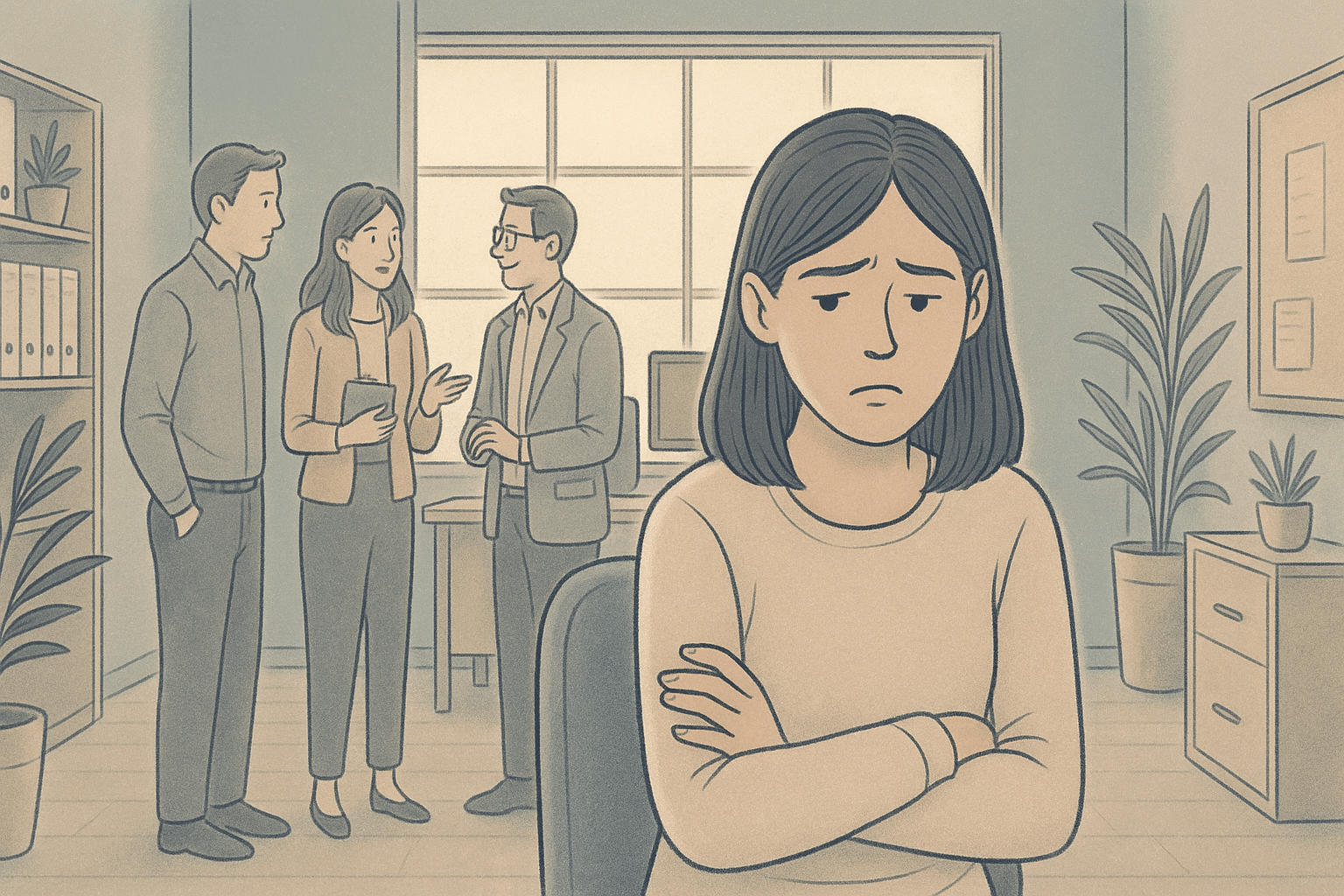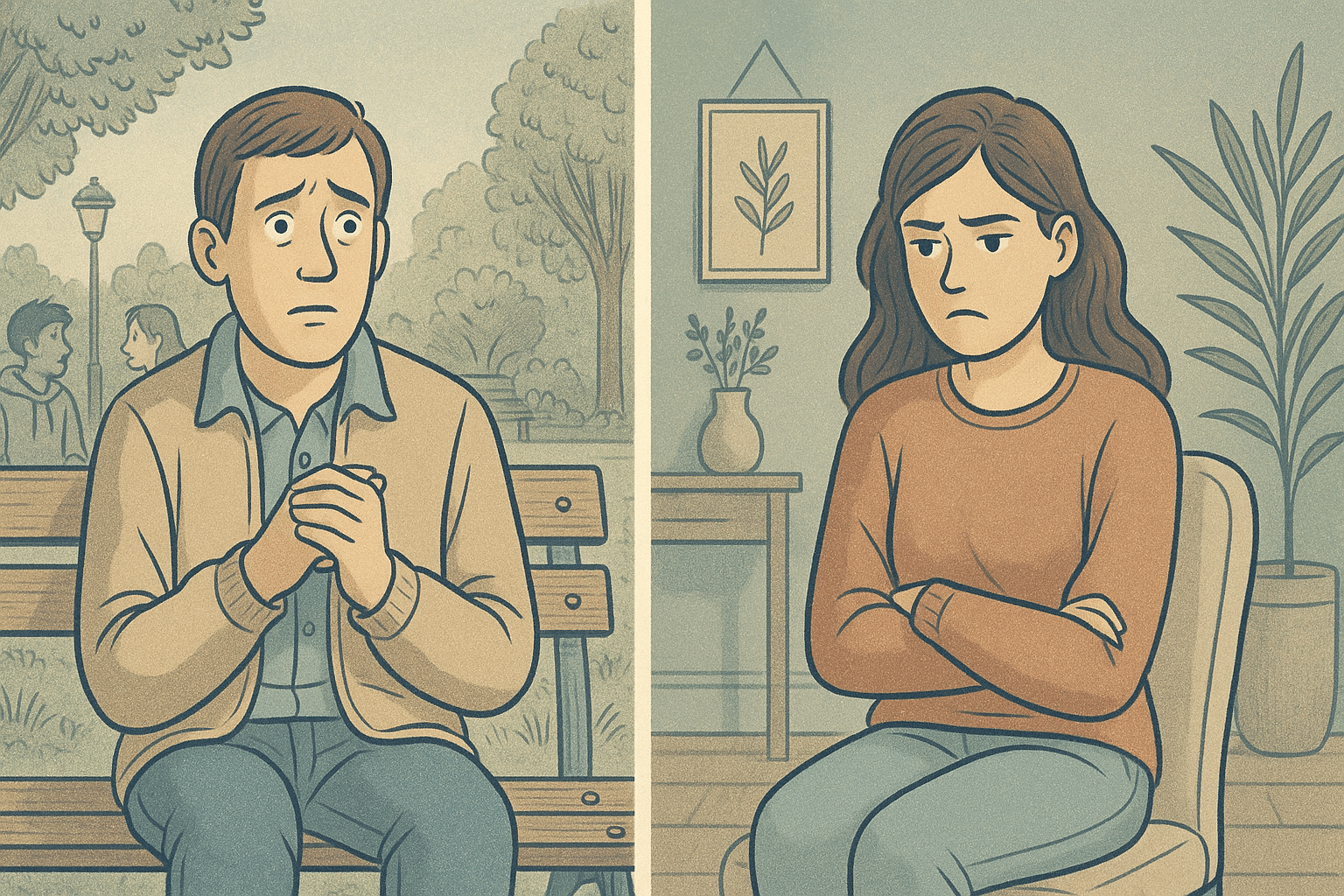Key Takeaways
- Avoidant Personality Disorder (AVPD) and Social Anxiety Disorder (SAD) share common features like fear of judgment and social avoidance, but are distinct clinical conditions with different diagnostic criteria.
- Social Anxiety Disorder typically focuses on specific social situations and performance fears, while Avoidant Personality Disorder involves a pervasive pattern of social inhibition affecting one’s entire identity and life.
- People with Social Anxiety often recognize their fears as excessive, while those with AVPD tend to believe their social inadequacy is real and justified.
- These conditions can co-occur in some cases, making proper differential diagnosis challenging but essential for effective treatment.
- A Mission For Michael’s experienced clinicians offer evidence-based therapies including CBT for social anxiety and longer-term interventions like schema therapy for AVPD. We provide a comprehensive assessment to give you an accurate diagnosis and effectively plan your treatment.
When Fear Controls Life
Fear is a universal human experience, but when it begins to dictate your choices and limit your potential, it may indicate something more serious than everyday nervousness. Both avoidant personality disorder (AVPD) and social anxiety disorder (SAD) represent patterns where fear takes control, but they manifest in distinctly different ways.
Before going into the specifics of each condition, recognize that these disorders aren’t simply labels but represent real struggles that affect millions of people worldwide. When we understand the precise nature of these conditions, we can provide more targeted support and effective approaches to treatment.
| A Mission For Michael: Expert Mental Health Care Founded in 2010, A Mission For Michael (AMFM) offers specialized mental health care across Southern California, Minnesota, and Virginia. Our accredited facilities provide residential and outpatient programs, utilizing evidence-based therapies such as CBT, DBT, and EMDR. Our dedicated team of licensed professionals ensures every client receives the best care possible, supported by accreditations from The Joint Commission and the California Department of Health Care Services. We are committed to safety and personalized treatment plans. Start your recovery journey with AMFM today! |
Social Anxiety Explained
Social anxiety disorder, sometimes called social phobia, is characterized by intense fear of social situations where one might be scrutinized, judged, or embarrassed.

Social anxiety disorder is a persistent fear of social gatherings that can significantly impair daily functioning.
Unlike occasional nervousness about public speaking or meeting new people, SAD involves a level of distress that interferes with normal life activities.
Key Symptoms
The hallmark of social anxiety is an overwhelming fear of negative evaluation in social settings. Physical symptoms often accompany this fear, including rapid heartbeat, sweating, trembling, nausea, and even full-blown panic attacks.
Cognitive symptoms are equally prominent, with individuals experiencing racing thoughts, mind-blanking during conversations, excessive self-consciousness, and intense worry about saying or doing something embarrassing. These symptoms can be so severe that the individual goes to great lengths to avoid triggering situations, leading to significant life limitations.
Diagnostic Criteria
According to the Diagnostic and Statistical Manual of Mental Disorders (DSM-5), social anxiety disorder is diagnosed when a person experiences marked fear or anxiety about one or more social situations in which they might be scrutinized by others. These fears must be out of proportion to the actual threat posed by the social situation, persist for 6 months or more, and cause significant distress or functional impairment.
Importantly, individuals with social anxiety typically recognize that their fear is excessive or unreasonable, even if they cannot control it. This insight is a key differentiating factor from avoidant personality disorder.
Real-Life Impact
The consequences of social anxiety can be far-reaching. Many individuals with SAD miss educational or career opportunities due to their fear of speaking up in class or job interviews. Relationships may be limited as social gatherings are avoided, leading to isolation.
Avoidant Personality Disorder

Avoidant Personality Disorder (AVPD) involves a fear of rejection that extends beyond specific social situations.
Avoidant Personality Disorder (AVPD) represents a more pervasive pattern of social inhibition, feelings of inadequacy, and hypersensitivity to negative evaluation. Unlike social anxiety, which centers on specific fear responses, AVPD is woven into the fabric of an individual’s personality and self-concept.
Core Features
The essence of AVPD lies in a profound sense of personal inadequacy and fear of rejection that extends beyond specific social situations. Individuals with AVPD typically view themselves as socially inept, personally unappealing, or inferior to others. This self-perception isn’t limited to performance situations but represents a fundamental belief about who they are as people.
Unlike those with social anxiety who might engage socially despite their discomfort, people with AVPD typically avoid nearly all social contact unless they’re certain of acceptance. This avoidance becomes a defining feature of their lives, leading to extreme isolation and missed opportunities for connection, growth, and fulfillment.
Diagnostic Framework
According to the DSM-5, AVPD is diagnosed when an individual shows a pervasive pattern of social inhibition, feelings of inadequacy, and hypersensitivity to negative evaluation. At least four of seven following criteria must be met:
- Avoiding occupational activities involving significant interpersonal contact
- Being unwilling to get involved with people unless certain of being liked
- Showing restraint in intimate relationships due to fear of shame or ridicule
- Being preoccupied with criticism or rejection in social situations
- Being inhibited in new interpersonal situations due to feelings of inadequacy
- Viewing oneself as socially inept or inferior
- Being unusually reluctant to take personal risks due to fear of embarrassment
As a personality disorder, AVPD must represent a long-standing pattern that begins by early adulthood and presents across various contexts. This enduring nature distinguishes it from more situational anxiety disorders and presents unique treatment challenges.
Daily Struggles
The impact of AVPD on daily life is profound and extensive. Individuals may forego career advancement to avoid scrutiny, maintain few or no close friendships, and avoid romantic relationships entirely due to fear of intimacy and potential rejection.
The pervasive nature of this avoidance often leads to severe social isolation, which can worsen the condition as social skills atrophy from lack of practice. This creates a vicious cycle where avoidance leads to greater social difficulty, which then reinforces the belief that avoidance is necessary, further entrenching the pattern.
Critical Differences

Despite their similarities, social anxiety disorder and avoidant personality disorder represent distinct clinical entities with important differences.
Severity
While both conditions can be debilitating, avoidant personality disorder typically represents a more severe and pervasive pattern of impairment. Social anxiety may be limited to specific situations like public speaking or eating in public, allowing the individual to function well in other contexts.
By contrast, AVPD affects virtually all social domains and represents a more global impairment in interpersonal functioning. Individuals with AVPD often have more significant functional impairment across multiple life domains, including work, relationships, and self-care.
Impact on Identity
A crucial distinction between these conditions lies in how they affect identity. Social anxiety disorder is an anxiety condition that someone experiences; it’s something they have, not who they are. Individuals with social anxiety often recognize their fears as excessive or irrational, even if they cannot control them. This insight creates a separation between the person and their condition.
Avoidant personality disorder, however, is integrated into the individual’s personality structure and sense of self. People with AVPD typically believe their social inadequacy is real and justified, rather than recognizing it as an excessive fear. This condition becomes woven into their identity, making it more difficult to challenge or change these patterns.
Onset Patterns
The development trajectory of these conditions differs significantly. Social anxiety disorder can emerge at any age, though it often begins in adolescence when social evaluation becomes more prominent. It may develop following a specific embarrassing experience or gradually over time. Some individuals clearly remember functioning well socially before the onset of their anxiety.
Avoidant personality disorder, like all personality disorders, begins to develop in adolescence or early adulthood as personality solidifies. Its roots typically extend back to childhood experiences, with many affected individuals reporting they’ve “always been this way.” This developmental difference has important implications for treatment approaches and expectations for change.
Situational vs. Global
Social anxiety disorder tends to be situational, with fear triggered by specific social contexts. A person might be comfortable with friends and family but terrified of speaking in meetings or attending large gatherings. The anxiety is typically linked to performance or evaluation concerns in particular settings.
AVPD, by contrast, represents a global pattern of social inhibition and inadequacy that persists across nearly all social contexts. Even in relatively “safe” relationships, individuals with AVPD maintain a guard against potential rejection or criticism. This pervasive pattern reflects the personality-level nature of the condition rather than a specific situational fear.
Condition Comparison
| Feature | Social Anxiety Disorder | Avoidant Personality Disorder |
| Classification | Anxiety disorder | Personality disorder |
| Core Fear | Embarrassment/humiliation in social situations | Rejection and criticism in any interpersonal context |
| Self-Awareness | Typically recognizes fears as excessive | Usually believes inadequacy is real |
| Onset | Can develop at any age, often adolescence | Develops by early adulthood as personality forms |
| Scope | May be limited to specific situations | Pervasive across nearly all social contexts |
| Treatment Response | Often responds well to short-term interventions | Typically requires longer-term treatment |
Effective Treatments
Therapy Approaches
Cognitive Behavioral Therapy (CBT) is the gold standard treatment for social anxiety disorder. This approach helps individuals identify and challenge distorted thought patterns while gradually facing feared situations through exposure exercises. For social anxiety, a structured CBT protocol typically lasting 12–16 weeks has strong research support, with many individuals experiencing significant symptom reduction.
For avoidant personality disorder, therapy often needs to be longer-term and may incorporate elements of schema therapy, which addresses core beliefs about oneself, or Dialectical Behavior Therapy, which helps develop emotional regulation and interpersonal effectiveness skills. Since AVPD involves personality structures, treatment typically focuses on gradually reshaping these patterns rather than eliminating specific fears.
Medication Options
Pharmacological interventions can play an important role in treatment, particularly for social anxiety disorder. Selective serotonin reuptake inhibitors (SSRIs) are typically considered first-line medications for SAD, with research showing they can significantly reduce anxiety symptoms and improve functioning. These medications may take several weeks to reach full effectiveness but can provide substantial relief for many individuals.
Medication for AVPD is less straightforward, as there are no FDA-approved medications specifically for personality disorders. However, medications may be helpful in treating specific symptoms or co-occurring conditions like depression or anxiety. SSRIs may reduce sensitivity to rejection, while other medications might target specific symptoms like social inhibition or emotional dysregulation.
Self-Help Strategies
While professional treatment is often necessary for significant symptoms, several self-help approaches can complement formal therapy. Gradual exposure to feared situations, mindfulness practices, and social skills training can all contribute to improvement.
For those with milder symptoms or those waiting to begin treatment, resources like workbooks, support groups, and educational materials can provide valuable information and coping strategies. However, we emphasize that self-help is most effective when combined with professional guidance, particularly for individuals with more severe or complex presentations.
Comprehensive Treatment for Social Fears at AMFM
At A Mission For Michael, we recognize that accurate diagnosis forms the foundation of successful treatment. Our experienced clinicians conduct thorough assessments to distinguish between these conditions, even when they co-occur.
If you’re experiencing specific social anxiety or the more encompassing patterns of AVPD, our evidence-based treatment approaches address both the immediate symptoms and underlying causes. Our comprehensive care model integrates proven therapies including CBT for social anxiety and longer-term interventions like schema therapy for personality-level change.

We understand that social anxiety may respond relatively quickly to structured treatment, while AVPD requires patience and persistence. That’s why our modern facilities create the perfect environment needed to encourage healing.
Recovery from social fears is about building a life of meaningful connection and authentic self-expression. Contact us today to begin your journey from isolation to connection with compassionate, specialized care designed for your unique needs.
Frequently Asked Questions
Can someone have both Avoidant Personality Disorder and Social Anxiety simultaneously?
Yes, it’s quite common for individuals to meet criteria for both conditions simultaneously. Research indicates that people with AVPD often have social anxiety disorder. When both conditions co-occur, treatment typically addresses both the acute anxiety symptoms and the more enduring personality patterns. We often begin with addressing anxiety symptoms to build momentum and confidence.
Which condition is more severe: AVPD or Social Anxiety?
AVPD typically represents a more severe and pervasive pattern of impairment. Social anxiety may be limited to specific situations, allowing individuals to function well in other contexts. AVPD affects virtually all social domains and represents more global impairment across multiple life areas including work, relationships, and self-care.
How do treatment approaches differ between these conditions?
Social anxiety disorder often responds well to structured CBT protocols lasting 12–16 weeks, focusing on challenging distorted thoughts and gradual exposure to feared situations. AVPD typically requires longer-term treatment incorporating schema therapy or dialectical behavior therapy to address deeply ingrained personality patterns and core beliefs about oneself.
At what age do these conditions typically develop?
Social anxiety disorder can develop at any age, though it most commonly begins in adolescence or early adulthood, sometimes following specific embarrassing experiences. AVPD, like other personality disorders, typically develops by early adulthood as personality structures solidify, with roots often extending back to childhood experiences.
How does AMFM approach treatment when both conditions are present?
At A Mission For Michael, we conduct comprehensive assessments to accurately diagnose both conditions when they co-occur. Our integrated treatment approach often begins with CBT techniques to address acute anxiety symptoms while incorporating personality-focused interventions as treatment progresses, ensuring that both the situational fears and deeper personality patterns are addressed effectively.






